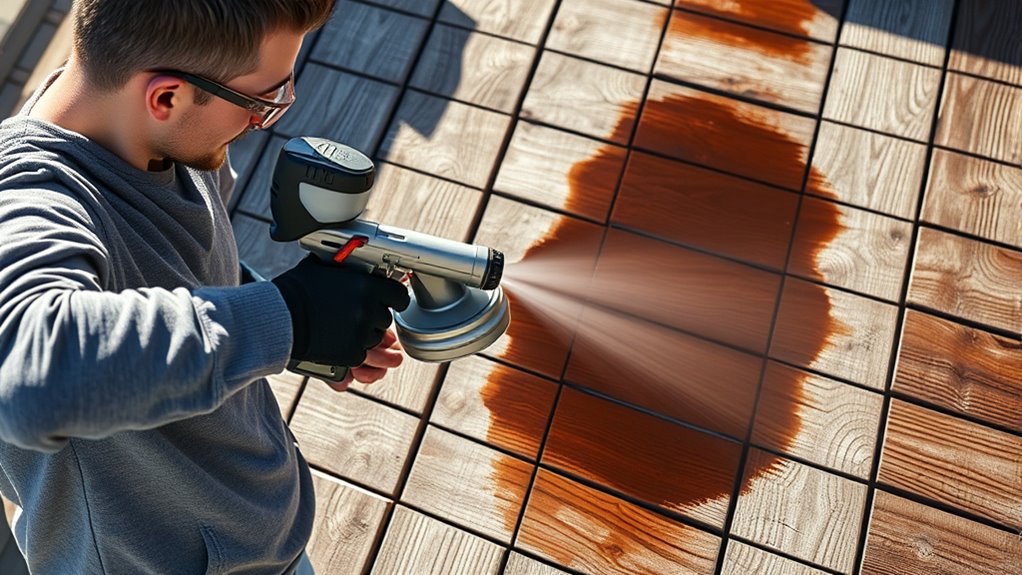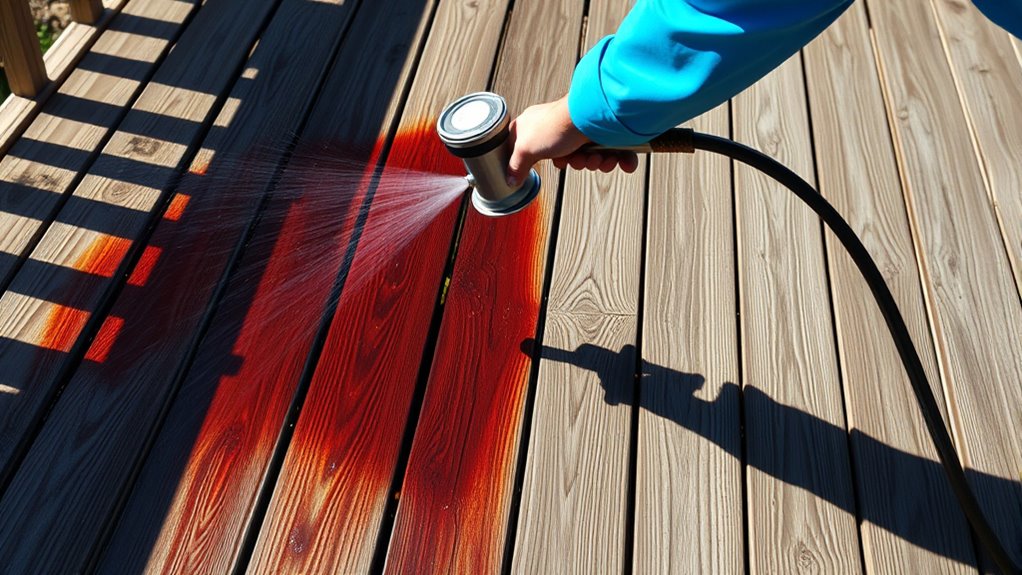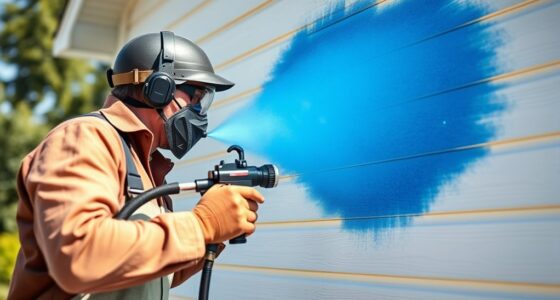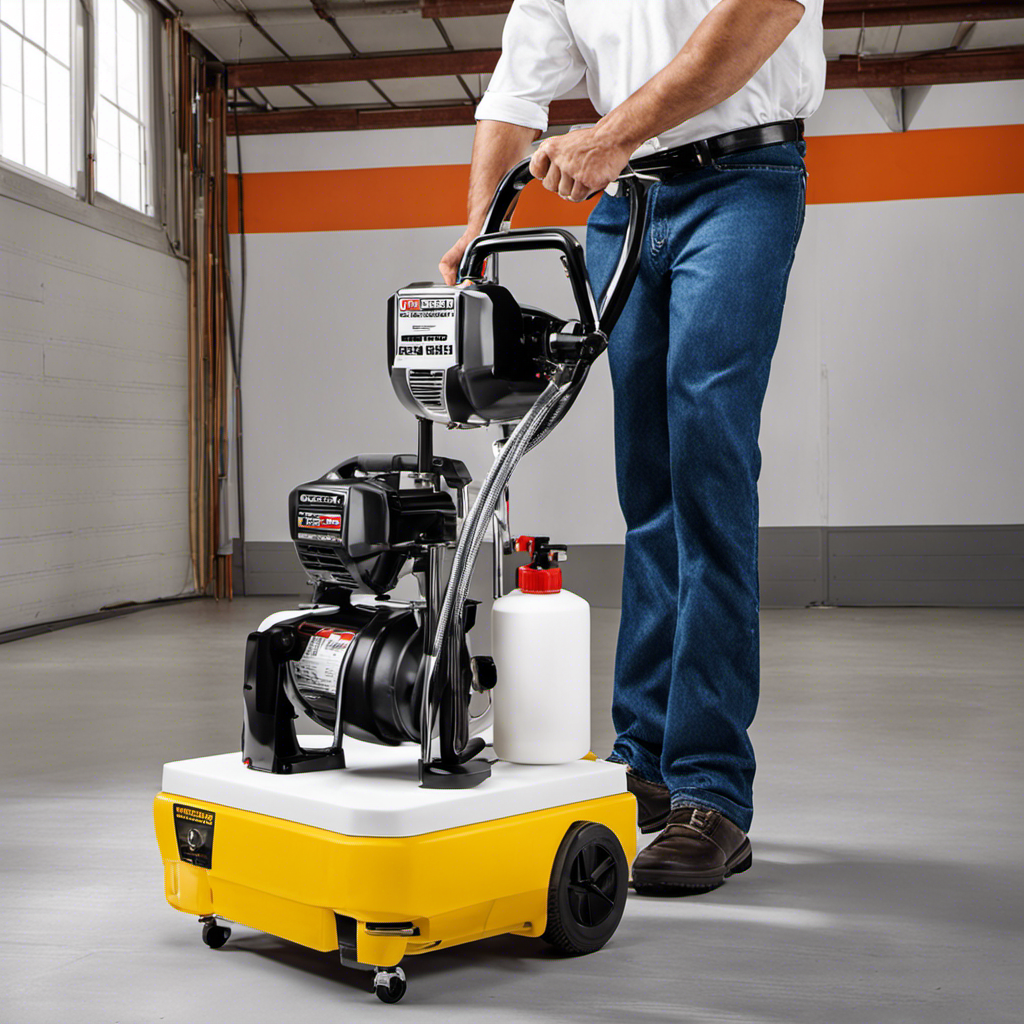To stain your deck quickly and evenly with a paint sprayer, start by thoroughly cleaning and drying the surface. Set up your sprayer according to instructions and test it on a scrap piece. Keep a consistent distance of 6-12 inches while moving steadily, overlapping each pass slightly. Use a brush to blend edges and reach tight areas for a flawless finish. Proper prep, technique, and maintenance are key—continue exploring for even better results.
Key Takeaways
- Ensure the deck surface is clean, dry, and properly prepared before starting to prevent uneven staining.
- Set up and test the paint sprayer on a scrap area to adjust settings for consistent coverage.
- Maintain a steady 6-12 inch distance and overlap passes to achieve even, streak-free results.
- Use brushes to blend edges, corners, and touch-up areas for a uniform finish.
- Regularly clean and maintain the sprayer during use to prevent clogs and ensure smooth application.

Have you ever wondered if staining a deck with a paint sprayer is faster and easier than traditional methods? Using a sprayer can substantially cut down your project time, but it requires some skill and preparation to get the best results. The key to achieving a smooth, even stain lies in mastering brush techniques and maintaining your equipment properly. Before you start, make sure your deck is clean and dry. Any dirt, dust,, or moisture can cause uneven absorption, leading to blotchy results. Once prepared, set up your paint sprayer according to the manufacturer’s instructions, and test it on a scrap piece or a hidden section of the deck to adjust spray patterns and flow rates.
Using a sprayer speeds up staining, but proper preparation and technique ensure a smooth, even finish.
When it comes to applying stain with a sprayer, your brush techniques play a vital role. While the sprayer does most of the work, it’s essential to keep a consistent distance from the surface—usually about 6 to 12 inches—and move steadily to avoid overspray or thin spots. Overlap your passes slightly to ensure full coverage and avoid streaks. If you notice areas where the stain appears uneven, use a brush to feather out edges or reach tight corners. This blending with a brush prevents drips, runs, or uneven patches, especially in tricky spots like corners and edges. Keep a small brush handy for touch-ups and to work in tight spaces, ensuring every part of your deck looks uniform.
Maintaining your paint sprayer during the project is equally important. Regularly check for clogs or build-up in the nozzle, and clean it thoroughly after every few passes to prevent clogs and maintain a consistent spray pattern. Proper paint sprayer maintenance also involves cleaning the filters, hoses, and other parts as recommended by the manufacturer. Neglecting these steps can lead to uneven application, wasted stain, or equipment failure. A well-maintained sprayer delivers smooth, even coats, making your job easier and your finished deck more attractive.
In the end, combining proper brush techniques with diligent paint sprayer maintenance ensures you’ll achieve fast, even results. The sprayer’s efficiency saves time, but paying attention to detail—like overlapping strokes and keeping your equipment in top shape—makes all the difference. With a little practice and care, you’ll find staining your deck with a paint sprayer to be a straightforward, effective way to enhance your outdoor space quickly and beautifully. Additionally, understanding proper deck preparation is crucial for achieving optimal staining results.
Frequently Asked Questions
Can I Stain a Wet or Damp Deck?
You shouldn’t stain a wet or damp deck, as it can cause uneven absorption and poor adhesion. Before staining, make certain your deck has been properly cleaned and dried during good weather conditions. Check the weather forecast and avoid staining if rain or high humidity is expected. Allow your deck to fully dry after cleaning, typically 24-48 hours, to achieve the best results and ensure the stain penetrates evenly.
What Type of Paint Sprayer Is Best for Decks?
When choosing a stain sprayer for your deck, consider spray gun types like airless and HVLP models. An airless sprayer offers fast, even coverage perfect for large surfaces, while HVLP provides more control for detailed areas. Do a stain sprayer comparison to see which suits your needs best. For decks, an airless sprayer typically delivers faster results, but HVLP guarantees precision. Pick the right tool for efficiency and quality.
How Do I Prevent Paint Splatters on Nearby Surfaces?
To prevent paint splatters on nearby surfaces, you should start by covering them with drop cloths or plastic sheeting. Use masking tape to secure the edges of drop cloths and to protect areas like walls or railings. Keep your sprayer at a consistent distance and move smoothly to minimize overspray. Regularly check your surroundings and adjust your setup to make certain of a clean, professional-looking finish without mess.
Is It Necessary to Sand the Deck Before Staining?
Before staining your deck, you don’t always need to sand it, but proper deck preparation is essential for a smooth finish. If the surface’s rough or splintered, lightly sanding helps. Weather considerations also matter—wait for dry, mild days to prevent issues like peeling or uneven staining. Ensuring your deck is clean, dry, and free of debris will give you the best results, whether or not you sand beforehand.
How Long Should I Wait Between Coats?
Think of waiting between coats as giving the deck a breather to shine. Typically, you should wait 4 to 6 hours, but follow your stain’s instructions for the best results. This time allows the first coat to dry properly, ensuring even absorption for a smooth finish. During this period, review your techniques overview and safety precautions, like wearing protective gear, so you stay safe and achieve professional-looking results.
Conclusion
Now that you know how to stain your deck with a paint sprayer, you’ll save time and achieve a smooth, professional finish. Just imagine the compliments you’ll get from friends and family when they see your beautifully transformed outdoor space. Are you ready to enjoy your refreshed deck and create countless memories? With a little effort and the right tools, you can make it happen—so go ahead, get started, and take pride in your stunning new deck!
Franz came aboard the Paint Sprayer Zone team with a background in both journalism and home renovation. His articulate writing style, combined with a passion for DIY projects, makes him an invaluable asset. Franz has a knack for breaking down technical jargon into easy-to-understand content, ensuring that even the most novice of readers can grasp the complexities of paint sprayers.










